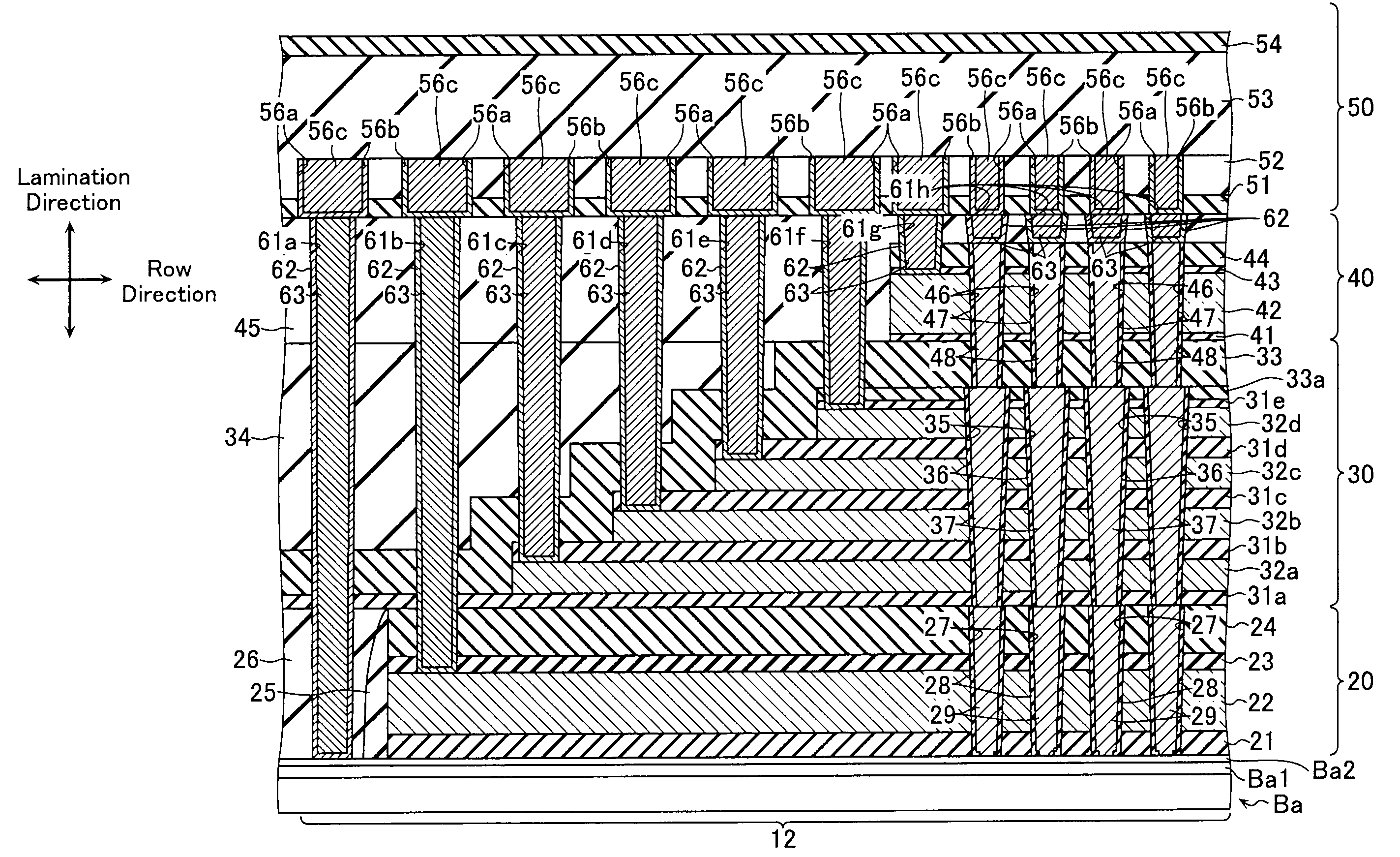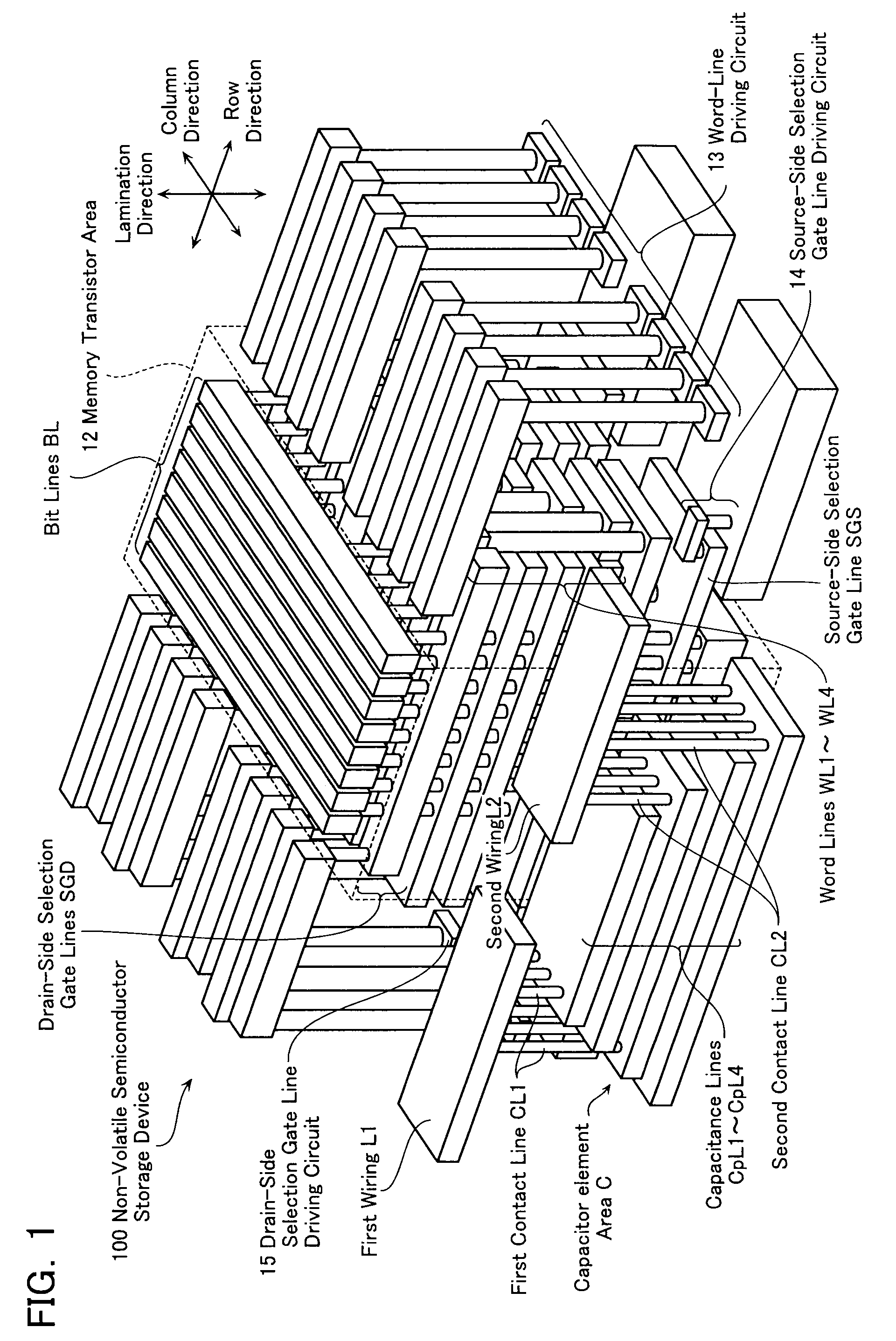Semiconductor storage device
a semiconductor and storage device technology, applied in the direction of semiconductor devices, resistors, electrical equipment, etc., can solve the problems of physical improvement limit, such as the breakdown voltage between devices, and the difficulty of overcoming such refinement challenges
- Summary
- Abstract
- Description
- Claims
- Application Information
AI Technical Summary
Problems solved by technology
Method used
Image
Examples
first embodiment
[0037](Configuration of Non-Volatile Semiconductor Storage Device 100 in First Embodiment)
[0038]FIG. 1 schematically illustrates a non-volatile semiconductor storage device 100 according to a first embodiment of the present invention. As illustrated in FIG. 1, the non-volatile semiconductor storage device 100 according to the first embodiment mainly comprises: a memory transistor area 12; a word-line driving circuit 13; a source-side selection gate line (SGS) driving circuit 14; a drain-side selection gate line (SGD) driving circuit 15; a sense amplifier (not illustrated); and a capacitor element area C.
[0039]The memory transistor area 12 has memory transistors for storing data. The word-line driving circuit 13 controls voltage applied to word lines (first conductive layers) WL. The source-side selection gate line (SGS) driving circuit 14 controls voltage applied to the source-side selection gate line SGS. The drain-side selection gate line (SGD) driving circuit 15 controls voltage ...
second embodiment
[0112](Specific Configuration of Non-Volatile Semiconductor Storage Device in Second Embodiment)
[0113]Referring now to FIGS. 9 and 10, a configuration of a non-volatile semiconductor storage device according to a second embodiment of the present invention will be described below. FIG. 9 is a schematic cross-sectional view illustrating a part of a capacitor element area Ca in the non-volatile semiconductor storage device according to the second embodiment; and FIG. 10 is a top plan view thereof. Note that the same reference numerals represent the same components as the first embodiment and description thereof will be omitted in the second embodiment.
[0114]As illustrated in FIGS. 9 and 10, the non-volatile semiconductor storage device according to the second embodiment has a capacitor element area Ca different from the first embodiment. The second embodiment is different from the first embodiment in the configurations of first contact lines CL1′ and second contact lines CL2′ in the ca...
third embodiment
[0121](Configuration of Non-Volatile Semiconductor Storage Device in Third Embodiment)
[0122]Referring now to FIGS. 11 to 13A, a configuration of a non-volatile semiconductor storage device according to a third embodiment of the present invention will be described below. FIG. 11 is a schematic top plan view of the non-volatile semiconductor storage device according to the third embodiment. FIG. 12 is a cross-sectional view taken along the line I-I′ of FIG. 11; and FIG. 13A is a cross-sectional view taken along the line II-II′ of FIG. 11. Note that the same reference numerals represent the same components as the first and second embodiments and description thereof will be omitted in the third embodiment.
[0123]As illustrated in FIG. 11, the non-volatile semiconductor storage device according to the third embodiment comprises a memory transistor area 12a having a plurality of memory strings MSa, and a capacitor element area Cb having capacitor elements. In the memory transistor area 12a...
PUM
 Login to View More
Login to View More Abstract
Description
Claims
Application Information
 Login to View More
Login to View More - R&D
- Intellectual Property
- Life Sciences
- Materials
- Tech Scout
- Unparalleled Data Quality
- Higher Quality Content
- 60% Fewer Hallucinations
Browse by: Latest US Patents, China's latest patents, Technical Efficacy Thesaurus, Application Domain, Technology Topic, Popular Technical Reports.
© 2025 PatSnap. All rights reserved.Legal|Privacy policy|Modern Slavery Act Transparency Statement|Sitemap|About US| Contact US: help@patsnap.com



